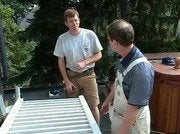We may earn revenue from the products available on this page and participate in affiliate programs. Learn More ›
Bob drops by the third Elmwood project house to watch as the deck is covered with rubber and the hot tub is installed. The conservatory/sunroom has been restructured with LVL beams to carry the hot tub load, and the joists have been covered with plywood sheeting.
To cover the deck with rubber, the workers first apply fiberboard insulation panels, which are held in place by anchoring plates and screws. A type of contact cement is then rolled onto the panels and the underside of the rubber roof material.
After the glue sets, the rubber top layer is rolled over the underlayment, slowly, so as to prevent air bubbles. This is a fully-adhered roof and all materials are held down with glue.
Now the roof is ready to accept the hot tub, which is being hoisted up by a crane and placed on the roof by the crew from Thermo Spas. These hot tubs are custom-fit for designers’ and clients’ needs, and, except for the wiring necessary for installation, they are entirely self-contained units.
Bob Vila: The conservatory roof has been restructured with LVLs to carry the load of the hot tub. The new joists have been covered with ¾” inch tongue and groove plywood sheathing. Next, contractor Joe Wagner covers the roof with half inch fiber board insulation panels that are specially treated to accept the glue for the rubber roof.
These panels are held in place with anchoring plates and screws. A type of contact cement is then rolled onto the insulation panels. The cement is also applied to the underside of the rubber roofing material. After the glue has set up, the rubber top layer is very carefully rolled over the underlayment.
This is done very slowly to keep air bubbles and wrinkles from forming. This is a fully adhered roof and the rubber material is held down everywhere with glue. The contact cement is very unforgiving. You really only get one chance at this.
Finally, the roof is covered. We’re ready for the hot tub. This is going to be a tricky operation. A crane is being used to lift the hot tub in its packing crate onto the conservatory roof.
The ThermoSpa is rapidly approaching your house, Dr. Peter Karczmar. This is the first time we’ve met you on the show. How do you feel about getting the hot tub delivered onto your new porch roof?
Dr. Peter Karczmar: Well, this is extremely exciting. Right now, what I’m really worried about is how the ThermoSpa is going to clear that tree. I really hope the structural engineer got the calculations just right because it’s a lot of weight that’s going up there.
Bob: It is a lot of weight. I think that it’s something like 100 pounds per square foot in terms of the live load, and that will add up to something like a ton and a half. They’ve done a heck of a job of restructuring that roof, so I wouldn’t worry too much about it.
Peter: They really did an amazing job, and I think it’s going to be a beautiful product at the end.
Bob: I just don’t recommend any block parties.
Peter: OK.
Bob: Andy Tournas is here from ThermoSpas. Andy, why not uncrate the thing on the ground, and then bring it up here.
Andy Tournas: Well, primarily because we’re doing a crane operation. We do about 8 to 10 percent of them as a crane. That’s where we send somebody out to the house to do a proper site inspection.
We always recommend that, with whatever hot tub that you buy. You want to really protect it as much as possible prior to lifting it up, and putting it on a deck.
Bob: Now, you guys refer to these as really being custom.
Andy: Yeah. Basically what Dell is to the computer industry, we are to the hot tub industry. We sell direct to the consumer, and then we custom them to fit the consumer’s needs.
Bob: Got you. Well, here come the wraps. Boy, you do quite a job of packing the thing, don’t you?
Andy: We do. We don’t want damage.
Bob: The beauty of these spas is that they’re totally self‑contained except for the wiring, right?
Andy: That’s right. You need a 220 volt, 60‑amp line for this particular ThermoSpa hot tub.
Bob: This has already been brought through the bottom there.
Andy: That’s correct. They’ve kind of positioned it. One of the advantages of the way that they insulate is the fact that its open interior allows you to be able to sneak it in at any position that you’re putting that wire.
The type of insulation that we use is a blanketed insulation which is quite different than what the rest of the industry does. They use more of a full foam which is adequate for insulation value, but it prevents the serviceability. This gives you same insulation with the serviceability.
Bob: The crew is just finishing up the connections on the control panel before we unwrap the hot tub. How much does that weigh, Andy, without any water in it?
Andy: Close to 1,000 pounds.
Bob: Three guys are gingerly letting it back down. Now, can we remove the plastic cover? All right. The moment we’ve been waiting for. What do you think, Peter?
Peter: Beautiful.
Bob: Go get the hose.
Peter: Yeah. Look at that. It’s gorgeous.
Bob: What do you call this finish?
Andy: This is a Lucite XL finish, and it has a micro‑ban anti‑bacterial inhibitor built right into it.
Bob: Wow! Now, I don’t think I’ve ever looked at an empty one of these. I don’t think I can count that high in terms of how many jets and bubbles and little gadgets are in here. Tell us more.
Andy: This is quite a few. The typical hot tub would have anywhere between 10, 15, 20 jets. This one has 56 jets in it. It has a total of four pumps. Three water pumps and one air pump.
The unique part about this is that we have a process that ThermoSpa calls Total Control Therapy. Each seat can be independently operated so that you’ve got independent controls. That button right there would control that therapy seat.
Bob: You can have four individuals in the hot tub and each person is getting a different type of hydro therapy.
Andy: Yeah, nobody dictates the other one what to do.
Bob: Sign me up.
Andy: OK.
Bob: Let’s get the hose.

